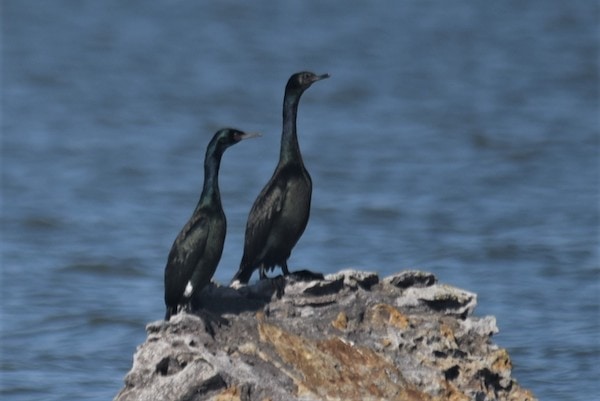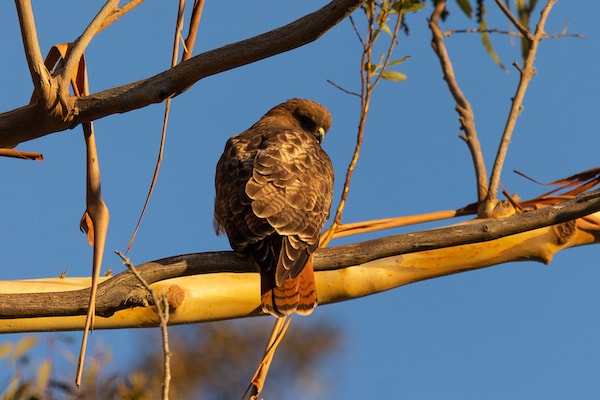Richmond Christmas Bird Count Takes Its Maiden Voyage
By Karyn Noel
It’s dark o’clock on the first sunday of 2022. I make coffee, pack my lunch, grab my bins and head toward my car to participate in the first-ever Richmond Christmas Bird Count. As a co-compiler, the joyful anticipation of this day has been building for months.
Ouch! It’s flippin’ freezing outside. No kidding – my birdbath is frozen solid, so I set my coffee cup on it and take a picture before de-icing my car. Luckily I’m on time to meet the group I’m supposed to lead in Hercules in the area around Sycamore Pond, Duck Pond, Frog Pond, and the Refugio Creek marshes surrounded by a young ~20 year old neighborhood adjacent to the San Pablo Bay.

The counters in my group are all amazed by how rich and productive the habitat is, (I say how “birdy”), in the middle of a planned community neighborhood. Hercules, of course, was named after one of the five dynamite factories that lined the shoreline at the turn of the last century.
Like the other 180 volunteer counters, we scoured all likely habitat and counted every bird we saw and/or heard. Counters included experts and novices. My favorite bird on my portion of the count was a pair of American White Pelicans spiraling up, up and over into another count area.
It was fun to hear the chatter across the group, such as whether or not it was okay to use recordings to flush a reluctant but known-to-the-area bird. The universe answered when the Green Heron we considered tricking, squawked and flushed without artificial prompt. Whew! Didn’t have to call the birding police in on that one!
With over 39 groups covering 19 different areas within the 15-mile diameter count circle, this was just a snippet of what it was like to be out that day.
Looking at the map, I’d say around 30% of the Richmond Christmas Bird Count footprint was on the Bay. In terms of sheer volume, of the 172 species reported and 48,677 individual birds seen, waterbirds made up more than 20% of the total with 6,386 scaups (greater, lesser & G/L) taking the top number followed by 3,733 Double-crested Cormorants. Special props to Bruce Mast for recruiting volunteer boat captain, Rich Holden. Thank you Bruce and Rich!

As far as surprises go during the count; Sam Zuckerman spotted four Tundra Swans at Dotson Marsh on December 30, giving an auspicious start to the count week. Other highlights were Short-eared Owl, Redhead, Black Scoters, Surfbird, Heermann’s Gull, Black Rail, Ferruginous Hawk, Northern Saw-whet Owl, Rock Wren, and Brown-headed Cowbird. Big misses included Pine Siskin, Red-necked Grebe, Wood Duck, Virginia Rail, Barrow’s Goldeneye and White-winged Scoter. The full eBird report can be found here: https://ebird.org/tripreport/29772

You may wonder what makes this count different than any other GGBA CBC. As a first year count, there are no historical CBC records and this is a baseline year. Co-compiler Derek Heins admits to spending 4-5 hours per day for the last six months co-creating this amazing event. We got to learn what it takes to put on a Christmas Bird Count and Derek’s batteries never ran out!
Most importantly, Golden Gate Bird Alliance furthered its mission in the communities and habitats of the Richmond CBC. With that said, several of us devoted our focus on cultivating community engagement, identifying under-birded areas, and sourcing other organizations to partner with to expand the protection of birds and their habitat. From this perspective, we found abundant opportunities for Golden Gate Bird Alliance to explore co-creating program content and activities that will enhance the outdoor activity options for individuals and families in the heavily-urbanized East Bay region of the SF Bay Area. While Golden Gate Bird Alliance holds regular walks in the area and its EcoEd program has been in the local schools, we are really excited to explore ways to deepen the organization’s commitment.
The North Richmond Marshes is an IBA–Important Birding Area, https://www.audubon.org/important-bird-areas/north-richmond-wetlands and GGBA volunteer Cathy Bleier did a lot of scouting of the inner urban creeks prior to leading her CBC group. What we are seeing, and want to share out, is that there are several creeks and attendant watershed areas that flow from the parks in the hills, through the dense urban areas, into the marshes and the Bay. This is fabulous habitat! GGBA has a great opportunity to partner with watershed restoration projects in the Richmond area, bringing more awareness of birds, and the joy of birding as watersheds are being restored in these communities and neighborhoods.

It was my dream to connect with community groups to introduce birding in areas that have not traditionally been pursued by the mainstream birding community. An example would be the fun that George Griffeth and Sam Zuckerman had leading their group to an area that included Salesian Preparatory High School in San Pablo. The school is a sweet refuge of a campus that shares a border with a newly restored section of Wildcat Creek. The school principal introduced Sam to an instructor who is also a birder, which opened the door to making students aware of the opportunity to participate in the count. May I point out that the count was the last Sunday of the long holiday break for students! Salesian student Sadie, Sam reports, is “a birding prodigy”.
“She was the first to spot and identify several of our species, and she was a delight to have with us. What’s amazing is that she’s almost entirely self-taught,” Zuckerman said. “There’s no telling how much she might develop if she avails herself of the resources of the broad birding community.”
Salesian is now established as an official eBird hotspot (https://ebird.org/hotspot/L17173035). Wow! Wow! Wow! Way to go, Sam and George!
Count leader Susana De Trapaga’s area included Fernandez Ranch (John Muir Land Trust).
“I met the rancher that has cattle at Fernandez Ranch while scouting and we talked. He was there on the count day. He came straight to me on his little ATV and said ‘I saw the new hawk you taught me!’. He didn’t remember the name but gave a perfect description of a Ferruginous tail,” Trapaga said. “The birders were surprised and I was proud. Besides hawks, we also talked rodenticides and I hope he goes to the RATS website as I suggested to find alternatives to second generation poisons.”

Friends, it has been an honor to be a part of creating the GGBA Richmond Christmas Bird Count. We stand on the shoulders of many strong and smart leaders before us (that’s you, Bob, Dave, and Dawn), and the amazingly talented area leaders and volunteer counters. Looking at the eBird roll-up, I personally want to get better at identifying the nine kinds of gulls that were sighted on that magical day. I also want to continue spreading the joy of birding in my home area of West Contra Costa. I want to learn more about the urban creeks and the birds there. What do you want to do with your birding this year?
